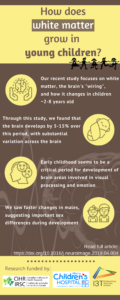 Behavior, motor and cognitive abilities, and emotional regulation develop in early childhood (2-8 years). The specific brain changes underlying these abilities in this age range are unknown. To better understand brain development in young children, we analyzed 396 diffusion imaging datasets which allow us to look at brain white matter (pathways that transfer information within the brain) from 120 children between 2 and 8 years of age. Results show that there is significant white matter development across the brain during early childhood. There was earlier development in females, but faster and greater development in males. Brain connections associated with motor function and communication between the left and right halves of the brain that support early rapid development during infancy show that their development is closer to complete in early childhood. Brain areas associated with language and emotion were less developed and seems that the behaviors they support will keep developing for many more years during later childhood and early adulthood. The fastest changes were found in areas associated with visual and other social-emotional functions, suggesting that early childhood is an important time for their development. Overall, this study helps to understand age-related changes in white matter during early childhood in typically developing children, which in turn can help identify differences from typical development in children with various diseases, developmental conditions, or brain injuries.
Behavior, motor and cognitive abilities, and emotional regulation develop in early childhood (2-8 years). The specific brain changes underlying these abilities in this age range are unknown. To better understand brain development in young children, we analyzed 396 diffusion imaging datasets which allow us to look at brain white matter (pathways that transfer information within the brain) from 120 children between 2 and 8 years of age. Results show that there is significant white matter development across the brain during early childhood. There was earlier development in females, but faster and greater development in males. Brain connections associated with motor function and communication between the left and right halves of the brain that support early rapid development during infancy show that their development is closer to complete in early childhood. Brain areas associated with language and emotion were less developed and seems that the behaviors they support will keep developing for many more years during later childhood and early adulthood. The fastest changes were found in areas associated with visual and other social-emotional functions, suggesting that early childhood is an important time for their development. Overall, this study helps to understand age-related changes in white matter during early childhood in typically developing children, which in turn can help identify differences from typical development in children with various diseases, developmental conditions, or brain injuries.